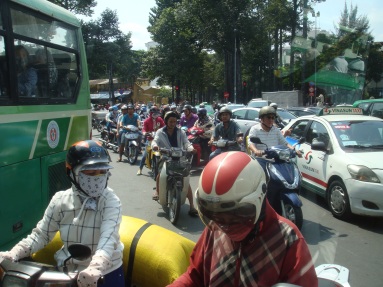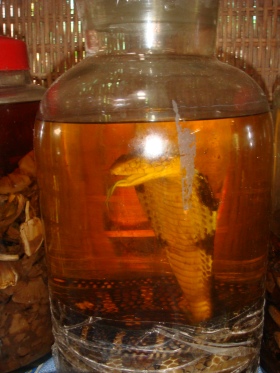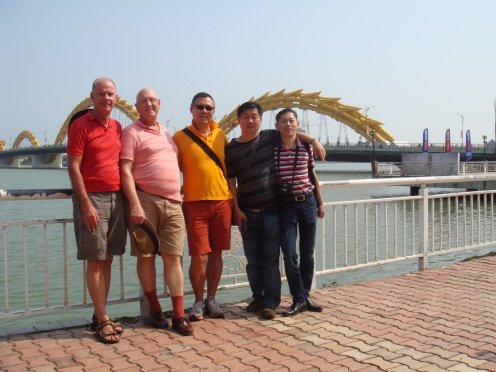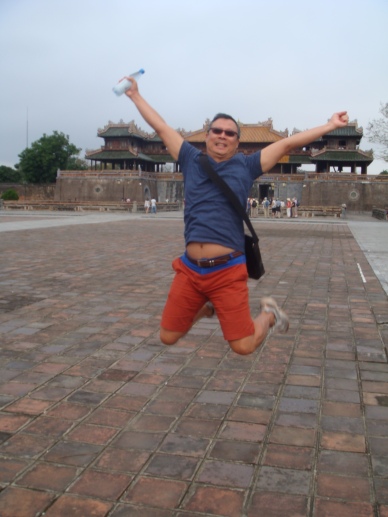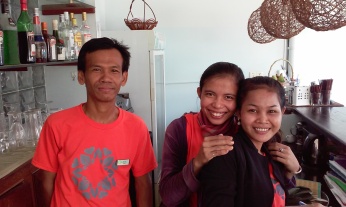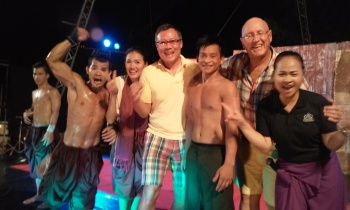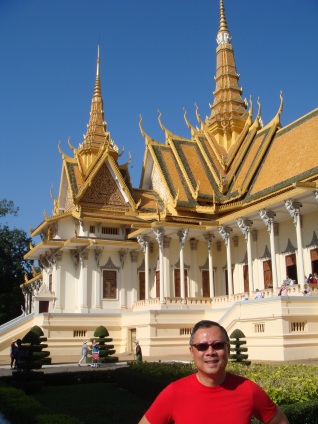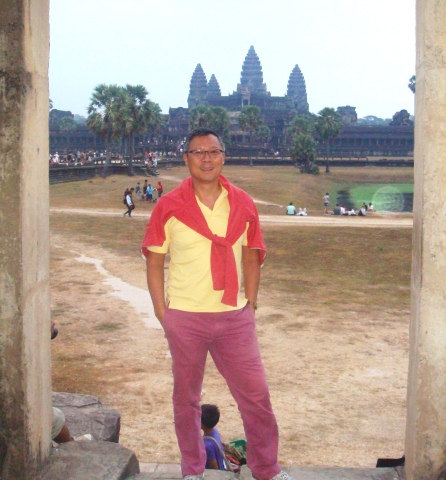We transferred to Viet Tri about thirty miles from Hanoi. Low water required that we start our eleven day boat cruise 15 kilometers down the Lo River. The cruise vessel accommodated thirty-two passengers if every bed was filled but our tour group made up of Australians, Brits, Americans and Singaporeans numbered eighteen. We were introduced to our guides Mr. Tifo and Mr. Than who gave an orientation for our trip and the ship.
As I mentioned in an earlier post each of our guides had a slightly different impression of the US involvement in Vietnam. Both our guides were from North Vietnam. Tifo was 46 years old and was cautious in what he said about the communist government. Several times he said, “You didn’t hear this from me.” He was interested in the current party congress until his opposition candidate did not get selected. He did not speak of the congress any further. His younger colleague, Than, who was thirty was much more optimistic about the future. He spoke often of how good things are in the country after 1986 when the communist experiment ended. Neither made very specific comments about the US history in Vietnam.
The use of the rivers for transportation in Southeast Asia started when the Scots came to Burma(now Myanmar) more than 120 years ago. They saw the great Irrawaddy River as key to commerce and developed a flotilla which grew to 1200 ships by the 1930’s. The Pandow Cruise Company reinstated river cruising not only on the Irrawaddy but now on the Mekong and the Red Rivers in Vietnam and Cambodia.
Our ship is similar to the ships that plied the rivers of Vietnam and Myanmar in the 1930’s with upgraded conveniences. The cabins have polished teak wood floors and walls. Cabin doors open to one side of the river or the other with louvered doors to let the air in and a second glass door to reduce noise and insure warmth. Our crew was mainly Cambodia where the company is based. Our crew like most Cambodians we met were sweet, gentle people wanting to serve.
We were the first group excursion to be in Viet Tri in 2016 and as a result we would be met by dignitaries from the local tourist council. The visit turned into a real media event as we were met by the Provincial Chief of the Communist Party, members of the tourist council, television cameras for interviews with members of our group. After receiving a flower lei of yellow chrysanthemums and red orchids and other gifts we were treated to traditional Vietnamese dancing by children and adults. We were then pulled into the dancing for many pictures and happy faces. We were treated like rock stars by the people.
The same morning we visited a family who made traditional conical hats. This was our first exposure to the tradition of multi-family members in business together. The business owner was the oldest woman we met and she was assisted by many family members. Her son and I traded hats. He gave me a new conical hat and I gave him my baseball cap. Pandow cruises takes you to out of the way places that buses can’t reach. I felt like an honored guest.
Sadly the next morning no cameras and microphones greeted us but we were met by friendly people at a village market. Tifo had great fun interacting with the women who sold food. We saw literally hundreds of local markets where people shop daily for their food.
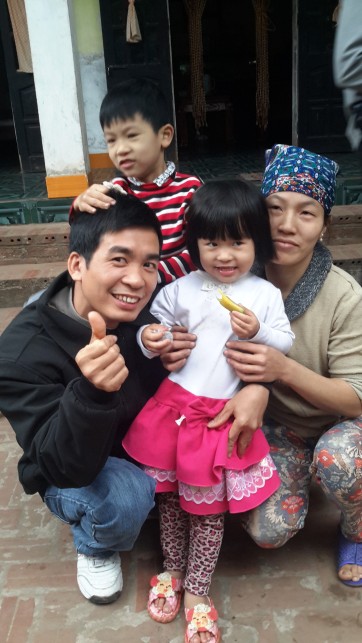
We walked through the village to a the blacksmith business owned by a man, his wife and assisted by other family members. They made machetes and other sharp cutting instruments from recycled iron and steel. Their son, the middleman, took the knives to market. This was followed by a visit to a carpentry village.
Tifo told us that our welcome was genuine since few tourists come to these communities. The best part of these days was interacting with the children.
Because all Vietnamese children begin learning English in the third grade the older children if they are brave enough ask you your name and where you are from in English. We took time always to answer their questions.
Each day we passed hundreds of rice paddies where farmers were planning one of the two rice crops for the year. Tifo explained that 41% of the people in Vietnam are farmers. A major dam on the Red River had been opened the previous day so the fields could be flooded for rice planting. The higher water in the river substantially increased the number of barges loaded to the gunnels with sand and gravel that were also moving. In Vietnam it is hard to describe how much sand is moved up and down the river from dredging operations and to fill construction needs.
Andrew and I sit in the back of the bus on our land excursions so we don’t have to see how close the bus driver comes to hitting pedestrians, bikes or motor bikes or being sideswiped by trucks twice out size. To suggest that we were not the first to have these feelings Tifo told us the following story: “On judgment day a monk and a bus driver were standing before the king of heaven hoping to be allowed to enter nirvana. The king of heaven said to the monk “You have been a good monk but please stand aside as I let the bus driver into nirvana.” The monk was shocked and begged, “Why are you letting the bus driver into nirvana before me?” The king of heaven said, “You have been a good monk but during your sermons people often fall asleep but from the bus driver’s bus I hear ‘Oh my Gawd, Oh my Gawd.’
I have resisted focusing on the weather but in a word it was very cold for our boat journey. We learned from the crew that cruising this time of year is often cold.
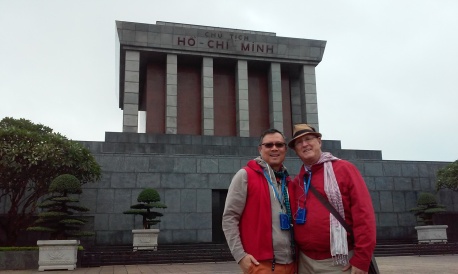
We started our day at the Ho Chi Minh Mausoleum where “Uncle” as he is affectionately referred to is buried. He did not want to be buried there and instead wanted to be cremated and have his ashes scattered in north, central and south Vietnam.
It didn’t happen and after his body was hidden for a while his body was entombed in a Russian style mausoleum that looks similar to the tombs of Mao and Stalin. Behind the tomb there is a series of houses where Ho Chi Minh lived alone since he never married even though it is rumored that he had a daughter in China. That fact has never been officially acknowledged. From these structures he and General Caip conducted the campaign to defeat the South Vietnamese government and the American Forces.
Ho Chi Minh died at age 79 in 1969 so didn’t live to see his dream of a unified Vietnam under Communist rule realized. He is revered and when we were in Hanoi the 12th Communist Party Congress was occurring. The Congress selected four new leaders to lead Vietnam for the next five years. Tifo and Than did an excellent job giving us the complete history of events in Vietnam. The chronology follows:
- 19th Century French came to Vietnam and remained until 1945
- 1946 they returned only to be expelled in 1954
- 1954 two governments – North and South were established but fighting did not stop
- 1965-1972 American war with North Vietnam. (We visited the Hanoi “Hilton” prison where American airmen were interred.) American forces left Vietnam in 1972
- 1979 – war ended with Paris Accord unifying Vietnam under Communist government. Many from the south were killed, reeducated or escaped by boat to the west.
When the Communist took over they instituted the collective farm program which existed until 1986 when it was declared a failure. The government remains Communist controlled but the economy is definitely western. We witnessed 1000’s of industrious farmers who work their own land. Merchants sell everything on almost every corner. Capitalistic principals are in evidence from north to south in Vietnam

The Pandow Angkor proceeded down the Red River for excursions visiting a bonsai village and a famous wooden Catholic Cathedral built in Vietnamese style. North central Vietnamese is heavily Catholic with accommodations for ancestor worship. In Binh Linh Province, which is called the “Halong on Land” we visited giant limestone mountains like those we would see two days later in world famous Halong Bay.
We were anchored in Halong Bay for two days among the almost 2000 limestone islands that grow out of the water. The weather was rainy but that didn’t stop us from paddling or kayaking through the caverns of the bay. We woke up each morning to marvel at the beauty of nature. The Pandow cruise was truly outstanding and was the highlight of our trip to Vietnam. We went places tourist don’t usually go. We were served by our excellent Cambodian crew. The food was interesting and regional. Our group got on exceptionally well. We highly recommend a river cruise with Pandow. Hopefully, the weather will be a bit warmer next time.
Andrew and I spent three nights in Hanoi. On our first night at the recommendation of Than, we found an authentic Vietnamese shop that sold Bun Bo Hue, a hot, spicy noodle soup that we had not been able to find previously. The soup is so spicy as not to appeal to many westerners. I tried it with Andrew and had to turn my bowl over to him. It was too spicy for me. We made it back to the hotel dodging taxis and motorbikes.
We ate so much on the cruise that we decided to eat late breakfast at the hotel and only have dinner. That we accomplished by eating in the old quarter of the city before attending the gigantic night market. We walked from the market to the peaceful lake surrounded by colorful dahlias and impatiens, yellow mums and budding cherry blossom trees all planted in advance of Chinese New Year on February 8. One of the funniest sites we witnessed numerous times was motor bikes with a large cumquat tree or cherry tree perched precariously speeding down a busy street. Most public spaces are blanketed in floral arrangements that give vibrant color to an otherwise gray city.
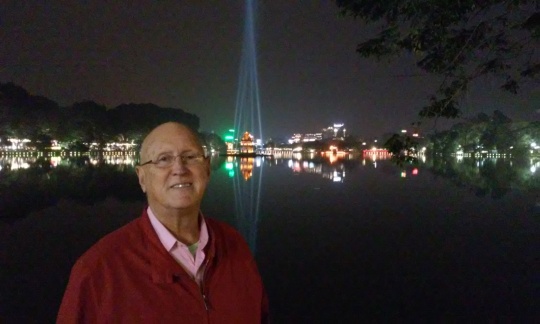
In the evening as we returned to the hotel we came upon couples dancing salsa, contemporary and traditional dances. We happily joined in. We walked the circumference enjoying the beautiful flower gardens. It was nice not to go anyplace or see anything that we didn’t want to. Relaxed we’re ready to fly to Myanmar.






